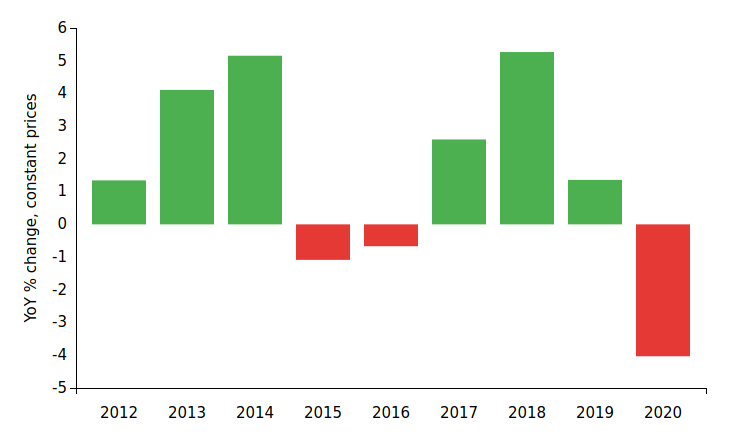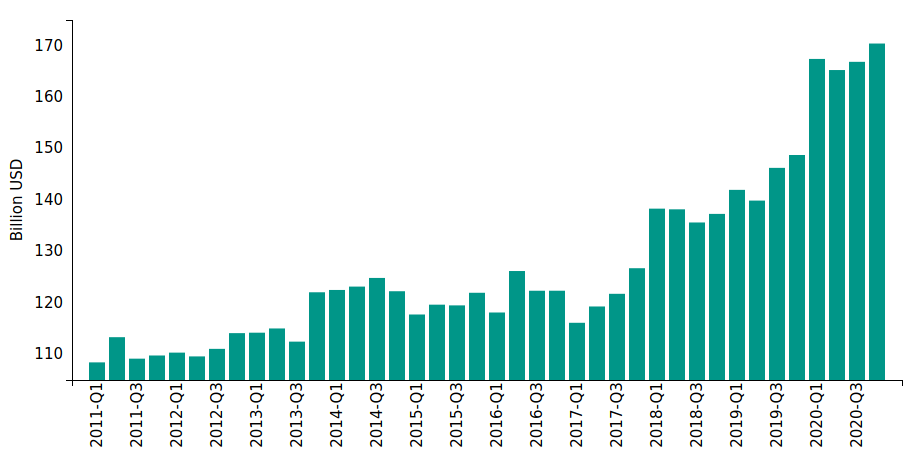 International trade data can represent an accurate barometer of the state of the health of the global economy, even more so in the current extraordinary circumstances, that require up-to-date monitoring for companies involved in international business. Recent trade data, up to Q4-2020, published by ExportPlanning and available on MarketResearch.com, can help in this process.
International trade data can represent an accurate barometer of the state of the health of the global economy, even more so in the current extraordinary circumstances, that require up-to-date monitoring for companies involved in international business. Recent trade data, up to Q4-2020, published by ExportPlanning and available on MarketResearch.com, can help in this process.
As for the industry of consumer goods, trade data show how differently the great lockdown and the COVID-19 emergency affected international exchanges among the various sub-sectors.
All in all, the consumer goods industry closed 2020 with an estimated fall of 4 percentage points in terms of global trade measured at constant prices, the sharpest downturn in years, as can be seen from the chart below (Fig. 1). In spite of a slight growth in Q4-2020 (+1.3% year-over-year at constant prices), world trade of consumer goods has not yet managed to fully recover from the loss experienced in the first part of the year (-8.7% YoY in H1-2020).
Fig. 1 - Global Demand for Consumer Goods

Source: ExportPlanning
In the broad spectrum of consumer goods, quite significant differences emerge at an industry level, with percentage changes in global demand in 2020 ranging from -18% YoY for the fashion industry to +11% for the pharmaceutical industry.
Fashion Industry: Severely Hit and Still Struggling
The most dramatic picture emerges for the fashion industry, in line with the general change in consumer preferences linked to the spread of the pandemic, that led to the prioritization of necessary goods to the detriment of consumer discretionary.
Global trade in the fashion industry fell by more than 18% in 2020, compared to the previous year. While recovering from the sharp 40% fall experienced in Q2 (constant prices, YoY), world trade in Q4 still looks far from pre-crisis levels: global demand for fashion showed a YoY drop greater than 7% in Q4-2020.
Looking closer at the several sub-sectors that make up the fashion industry, most of them experienced quite sharp falls in terms of global demand over 2020, as can be seen from the chart below (Fig. 2). Among the most penalized, we can find the segment of jewellery & watches (-30.7% YoY), as well as bags & suitcases, footwear, underwear and outerwear, which fell by about 20%.
Fig. 2 - Global Demand for Fashion Products (2020)

Source: ExportPlanning
The fashion industry therefore confirms its role as the consumer goods’ sector that has suffered the sharpest trade downturn due to the COVID-19 emergency.
Packaged Food and Consumer Packaged Goods: Back to Pre-Pandemic Levels
2020 closed, instead, in the name of stability for packaged food & beverage and other consumer packaged goods: in Q4-2020, world trade at constant prices appeared to be back to Q4-2019 levels for the two clusters, thus showing a complete recovery of the pandemic blow. For the whole of 2020, the fall in global demand for the two industries is estimated below 1%. As opposed to the fashion industry, the status of necessary goods of the two clusters under analysis sustained the demand, even in the year of the pandemic.
Fig. 3 - Global Demand for Packaged Food & Beverage and Consumer Packaged Goods

Source: ExportPlanning
Household and Healthcare on a Positive Note
Last but not least, household goods and healthcare products should be included in the analysis, particularly since they bucked the general trend. Indeed, the two clusters said goodbye to 2020 on a quite positive note: global demand in the two sectors respectively increased by 4% and 11% YoY, at constant prices, in Q4-2020.
While the pharmaceutical sector has certainly gained traction from the ongoing pandemic, showing double-digit YoY growth rates in all the four quarters of the year, purchases of goods for the home have rebounded in H2-2020, after an initial drop in H1. This rebound is nonetheless insufficient to close 2020 in positive territory: world trade of household goods is in fact estimated to have suffered a contained 2.6% fall over the last year; on the contrary, global demand in the pharmaceutical sector is estimated to have increased by more than 10% YoY. The healthcare sector therefore emerges as the strongest performer in terms of trade among consumer goods.
Focusing on world trade of drugs and medicaments, shown in the graph below, we can see that in Q4-2020 it reached a new record value ($170 billion), for a total amount of $670 billion for the whole of 2020.
Fig. 4 - World Trade of Drugs and Medications (USD)

Source: ExportPlanning
Keep Up to Date with the Latest Global Trade Trends
Need access to more internationa trade data? On MarketResearch.com, you can find a wide variety of ExportPlanning reports that can help you navigate foreign markets and their latest developments. Some examples include:
Fashion:
Home goods:
Packaged Food & Beverage:
UPDATE: For the latest insights, please see our new article "Consumer Goods Industry: 2021 Ushers in a Path to Recovery."
About ExportPlanning
ExportPlanning market research reports provide a broad overview of market trends (past, current, and expected) for all the relevant markets, as well as the position of the main competitor countries, for a specific strategic business unit (product, sector, or industry). They therefore, constitute very effective information support for companies willing to conduct thorough market research before entering a foreign market, or just looking to stay up to date with the latest trade trends in their industry. The reports make extensive use of data visualization to help the user grasp ideas and concepts quickly and effectively.

